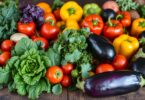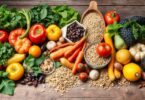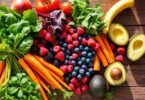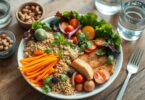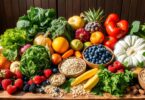Did you know that a staggering 90% of Americans do not consume the recommended daily intake of fruits and vegetables? This alarming statistic highlights the urgent need for a focus on nutrient-dense, whole foods in our diets. In this comprehensive guide, we’ll delve into the 10 best healthy food options. These can help you achieve a balanced and nourishing diet.
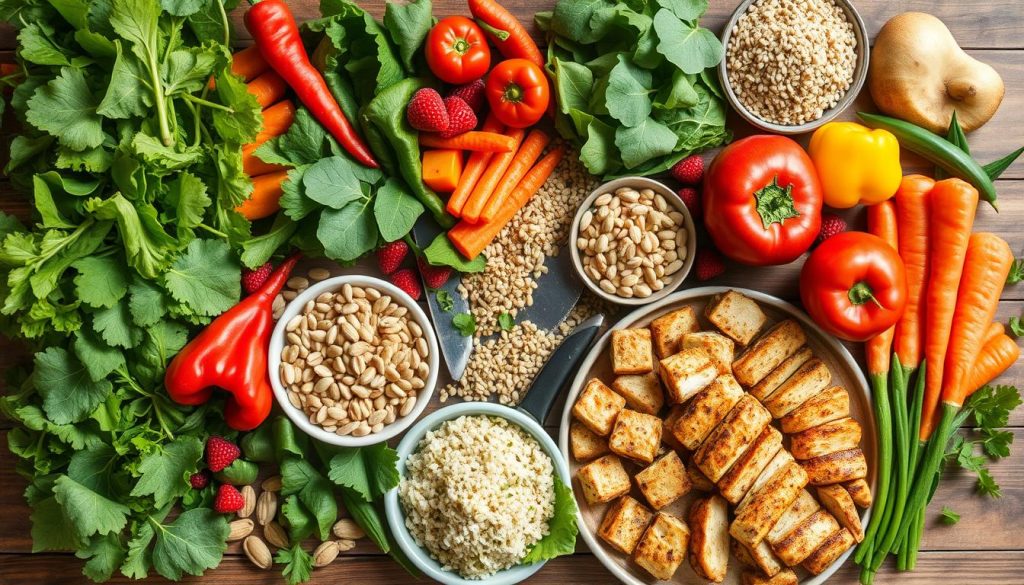
Key Takeaways
- Understanding the essential role of macronutrients and micronutrients in a balanced diet
- Discovering the top 10 healthiest food options to support long-term wellness
- Exploring creative ways to incorporate nutrient-rich foods into your daily meals
- Learning the benefits of plant-based proteins and heart-healthy fats
- Gaining insights on meal planning strategies for optimal nutrition
Understanding the Fundamentals of Nutritious Eating
Achieving a balanced and nutritious diet is crucial for optimal health and well-being. At the heart of this are the key macronutrients and micronutrients. They play vital roles in the body’s functions.
The Role of Macronutrients in Your Diet
Macronutrients, including carbohydrates, proteins, and fats, give the body the energy and building blocks it needs to thrive. Balancing these macronutrients is essential for maintaining a balanced diet and supporting overall nutrition.
Key Micronutrients for Optimal Health
Micronutrients, such as vitamins and minerals, are equally vital in supporting the body’s various systems and processes. Ensuring adequate intake of these nutrient-dense foods can help promote overall optimal health.
Daily Nutritional Requirements
Determining the appropriate daily nutritional requirements varies based on factors like age, gender, and activity level. Following a balanced diet that meets your individual needs is key to maintaining overall nutrition and well-being.
“Good nutrition is the bedrock of good health, and a balanced diet is essential for optimal physical and mental performance.” – Dr. Sarah Johnson, Nutritionist
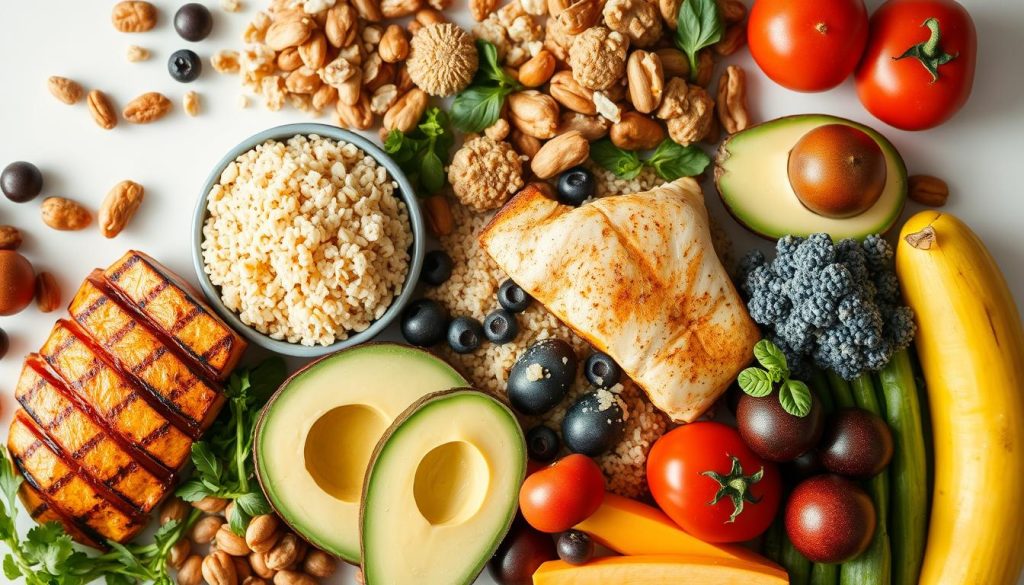
By understanding the fundamentals of nutritious eating, you can make informed choices. These choices support your body’s macronutrient and micronutrient needs. This leads to a more balanced diet and improved overall wellness.
Why Choosing Healthy Food Matters for Long-term Wellness
Adopting a clean eating lifestyle is more than a fleeting trend. It’s a thoughtful way to nourish your body and mind for enduring health and wellness. By integrating organic foods, anti-inflammatory ingredients, and nutrient-dense options into your daily life, you can enjoy the benefits of eating for wellness.
One key advantage of clean eating is its potential to prevent chronic diseases. Many whole, unprocessed foods are packed with antioxidants, fiber, and vital vitamins and minerals. These can help reduce inflammation and lower the risk of heart disease, diabetes, and some cancers. Eating a diet rich in anti-inflammatory foods can be a powerful tool for maintaining long-term wellness.
Moreover, a diet centered on clean eating can enhance your energy levels and overall well-being. Nutrient-dense whole foods offer the sustained energy your body needs to stay active throughout the day. Unlike processed, sugary foods, they don’t lead to energy crashes. By making conscious choices about the foods you eat, you can experience better mental clarity, improved sleep, and increased vitality.
“Eating well is not about deprivation, it’s about celebrating the abundance of delicious, nourishing ingredients nature has to offer.”
In conclusion, choosing clean eating and organic foods is an investment in your long-term health and happiness. By aligning your food choices with your wellness goals, you actively contribute to a healthier, more vibrant future.
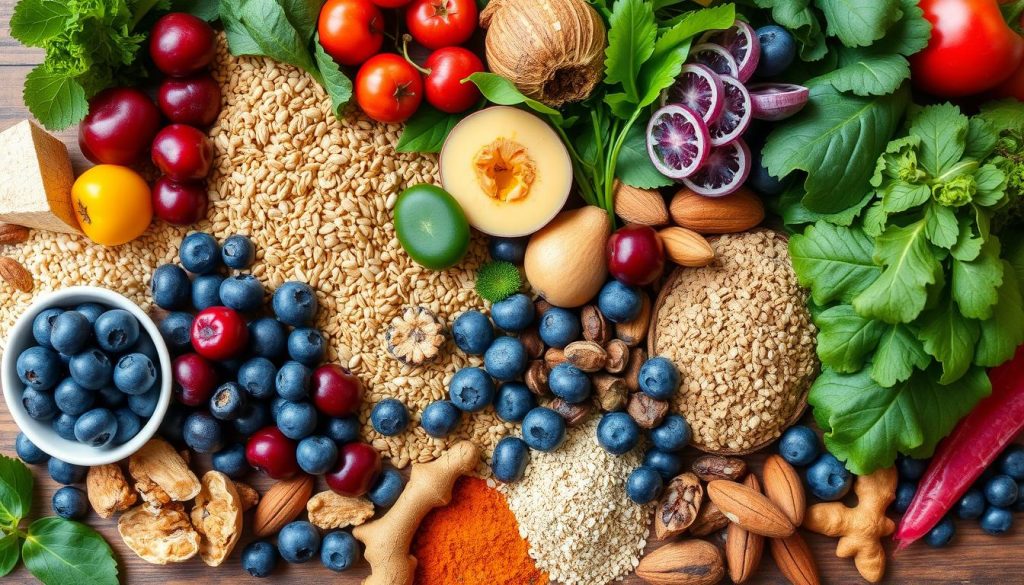
- Clean eating promotes disease prevention by reducing inflammation
- Nutrient-rich whole foods provide sustained energy and vitality
- Organic, unprocessed ingredients support overall well-being
Leafy Greens: The Foundation of a Nutrient-Rich Diet
Leafy greens are essential for a balanced, nutrient-dense diet. These dark leafy veggies are loaded with vitamins, minerals, and antioxidants. They significantly impact your health and well-being. Adding a variety of leafy greens to your meals boosts fiber intake and supports a plant-based lifestyle.
Best Types of Leafy Greens to Include
Diversity is crucial when it comes to leafy greens. Here are some of the most nutrient-rich options to add to your plate:
- Kale – High in vitamins A, C, and K, as well as calcium and antioxidants.
- Spinach – A powerhouse of vitamins, minerals, and antioxidants like lutein and zeaxanthin.
- Arugula – Packed with vitamin K, folate, and a unique peppery flavor.
- Swiss chard – Rich in vitamins A, C, and K, as well as magnesium and potassium.
- Collard greens – An excellent source of fiber, calcium, and vitamins C and K.
Creative Ways to Incorporate Greens Daily
Adding more dark leafy greens to your diet can be exciting. Here are some simple yet creative ideas to make them a regular part of your meals:
- Blend them into smoothies for a nutrient-dense breakfast or snack.
- Sauté them with garlic, olive oil, and a splash of lemon juice for a flavorful side dish.
- Add them to soups, stews, or pasta dishes for an extra boost of vitamins and minerals.
- Toss them into salads or use them as a base for plant-based meals.
- Roast them with a drizzle of olive oil and sprinkle of sea salt for a crispy, satisfying snack.
By making leafy greens a staple in your diet, you’ll enjoy the numerous health benefits they offer. These vitamin-rich foods are a key to a healthier lifestyle.
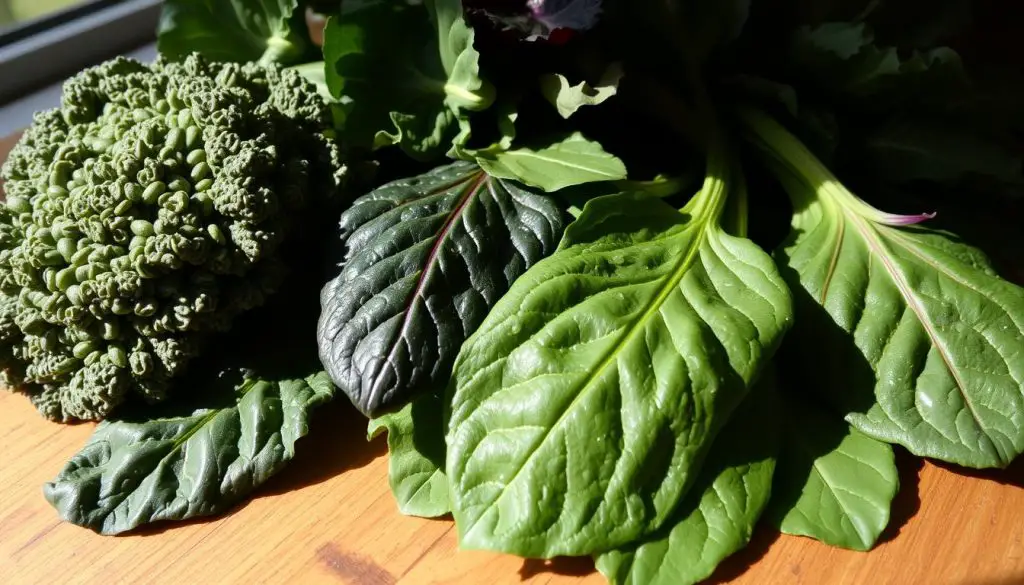
Lean Proteins: Essential Building Blocks for Your Body
Incorporating lean proteins into your diet is a crucial step towards achieving a balanced and nutritious lifestyle. These essential building blocks play a vital role in supporting muscle growth, repair, and overall body function. From lean meats to plant-based proteins, there is a range of protein sources to explore that can cater to various dietary preferences and fitness goals.
Lean proteins such as chicken, turkey, and fish are excellent choices, as they provide a concentrated source of amino acids without excessive fat or calories. For vegetarian options, tofu, tempeh, lentils, and plant-based proteins like quinoa and edamame offer high-quality protein that can be seamlessly integrated into a balanced diet.
“Incorporating a variety of lean proteins into your daily meals can help support muscle growth, repair, and overall body function.”
Whether you’re an athlete seeking to optimize fitness nutrition or a health-conscious individual looking to maintain a balanced diet, understanding the importance of lean proteins is crucial. These nutrient-dense options not only nourish your body but also contribute to a feeling of satiety, making them an invaluable component of a well-rounded, sustainable eating plan.
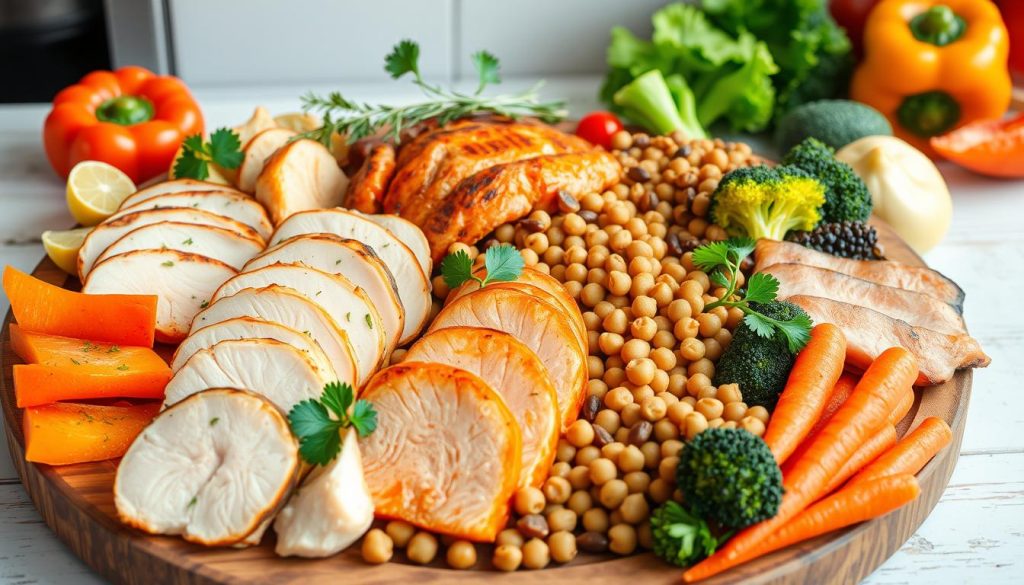
By prioritizing lean protein sources, you can unlock the myriad of benefits they offer, from supporting muscle development to promoting overall cellular health. Experiment with different protein-rich foods and find the options that best suit your taste preferences and dietary needs. This empowers you to embark on a journey towards optimal health and wellness.
Whole Grains and Complex Carbohydrates
Whole grains and complex carbohydrates are key to a balanced diet. They offer sustained energy, support digestive health, and are rich in vitamins and minerals. These fiber-rich foods are essential for a nutritious lifestyle.
Ancient Grains vs Modern Alternatives
Modern wheat and refined grains dominate many diets. However, ancient grains like quinoa, amaranth, and millet are nutrient-dense alternatives. These whole grains are rich in complex carbohydrates, fiber, and beneficial plant compounds. They support overall well-being.
- Ancient grains are often gluten-free options, making them suitable for those with gluten sensitivities or intolerances.
- Many ancient grains, such as buckwheat and teff, are also rich in protein, providing a valuable source of plant-based nutrition.
Preparing Whole Grains for Maximum Nutrition
To maximize the nutritional benefits of whole grains and complex carbohydrates, proper preparation is crucial. Cooking whole grains unlocks their full nutritional potential and enhances digestibility.
- Start by rinsing whole grains under running water to remove any impurities or debris.
- Use the recommended grain-to-liquid ratio when cooking, typically 1 part grain to 2-3 parts water or broth.
- Simmer whole grains gently until they’re tender and have a fluffy texture.
- Consider incorporating whole grains into soups, stews, or grain bowls for a nutritious and satisfying meal.

“Whole grains are a fantastic source of complex carbohydrates, fiber, and a wide range of essential nutrients that can support overall health and well-being.”
Heart-Healthy Fats and Omega-3 Sources
The importance of healthy fats in a balanced diet cannot be overstated. Healthy fats, particularly those found in the Mediterranean diet, play a crucial role in heart health and overall well-being.
Omega-3 fatty acids are among the most beneficial types of healthy fats. They are known for lowering triglycerides, reducing inflammation, and supporting cardiovascular function. The best sources of omega-3s include:
- Fatty fish, like salmon, mackerel, and sardines
- Flaxseeds and chia seeds
- Walnuts and almonds
- Avocados
Adding these heart-healthy foods to your diet offers numerous benefits. From improved heart health to enhanced cognitive function, making smart choices is key. Prioritizing nutrient-dense, omega-3-rich options nourishes your body and supports long-term wellness.
“Healthy fats are essential for our bodies to function at their best. Incorporating omega-3 sources like fatty fish and nuts into your diet is a simple way to boost your heart health and overall well-being.”
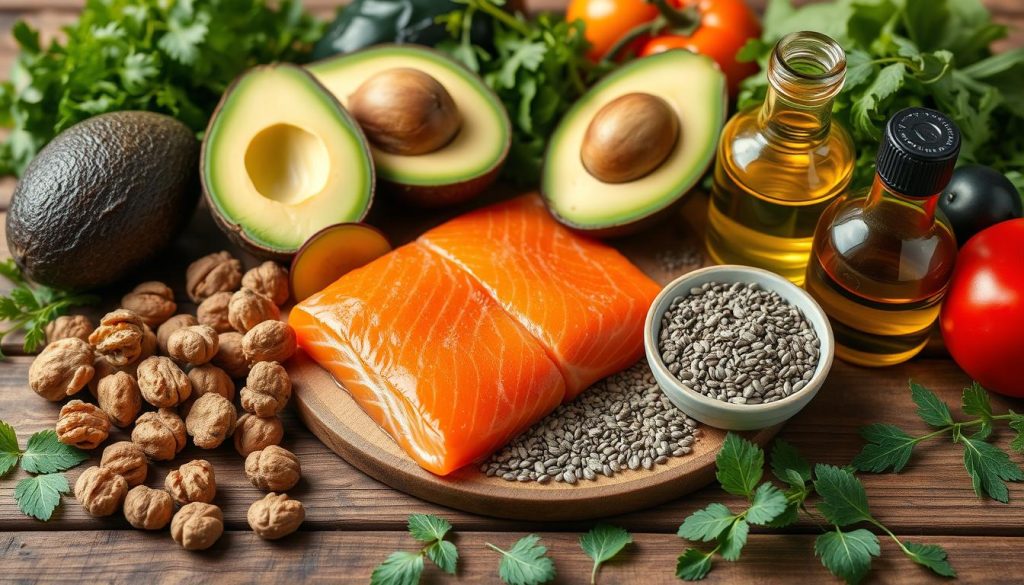
Fresh Fruits: Nature’s Sweet Nutrient Packages
Fresh fruits are a cornerstone of a balanced diet, offering a wealth of vitamins, minerals, and antioxidants. They are a treasure trove of health benefits. From the vibrant berries to the crunchy apples, the variety of fruits and vegetables is vast. Exploring this range can enrich our daily meals.
Seasonal Fruit Selection Guide
Knowing the best seasonal produce is crucial for maximizing fruit benefits. This guide will help you navigate the year’s offerings:
- Spring: Strawberries, mangoes, pineapples
- Summer: Peaches, plums, watermelon, blueberries
- Fall: Apples, pears, grapes, pomegranates
- Winter: Citrus fruits (oranges, grapefruit, tangerines), kiwi, persimmons
Opting for seasonal fruits boosts nutrient intake and supports local farmers. It also reduces environmental harm from long-distance transport.
Storage Tips for Maximum Freshness
Proper storage is essential to preserve the antioxidants and vitamin-rich qualities of fruits. Here are some tips:
- Store fruits in the refrigerator, except for bananas, avocados, and tomatoes, which should be kept at room temperature.
- Use a breathable container or paper bag to prevent moisture buildup and spoilage.
- Wash fruits just before eating to avoid premature spoilage.
- Freeze overripe fruits for smoothies or baking to reduce waste.
Incorporating a variety of seasonal fruits and following these storage tips ensures you enjoy their full nutritional benefits.
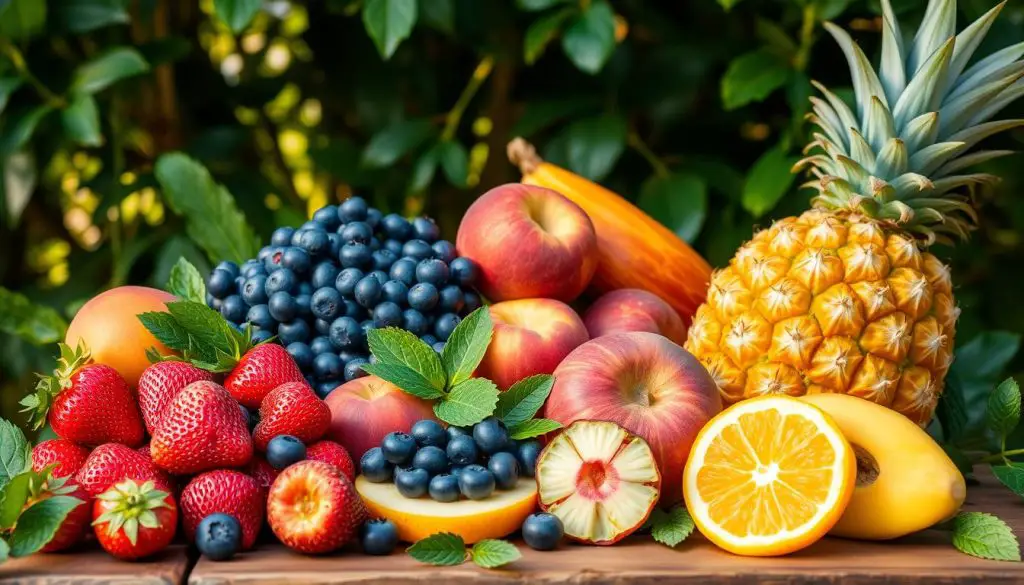
“Eating a variety of colorful fruits is an easy and delicious way to boost your intake of essential vitamins, minerals, and antioxidants.”
Plant-Based Protein Alternatives
In today’s health-conscious world, plant-based foods have become popular protein sources. Legumes and soy-based options offer a variety of nutritional benefits. Exploring plant-based proteins can diversify your diet and reduce environmental impact.
Legumes stand out as a top plant-based protein alternative. Beans, lentils, and peas are rich in fiber, complex carbohydrates, and protein. Adding these versatile ingredients to your meals can boost your daily protein intake.
Tofu and other soy-based products are also excellent protein sources. Tofu, a staple in many vegetarian and vegan diets, is incredibly versatile. Soy-based options like tempeh and edamame also provide a rich plant-based protein.
- Explore the wide range of plant-based foods available, including legumes, soy-based products, and ancient grains.
- Experiment with vegetarian options to add more variety and nutrition to your meals.
- Discover the benefits of incorporating plant-based protein sources into your diet for a more sustainable and balanced approach to eating.
“By embracing plant-based protein alternatives, you can nourish your body while contributing to a more sustainable food system.”
A balanced diet with a variety of plant-based protein sources meets your body’s nutritional needs. It also supports a more sustainable eating lifestyle.

Healthy Food Choices for Energy and Performance
Maintaining high energy levels and optimal physical performance requires a strategic nutrition approach. Whether you’re an avid fitness enthusiast or just looking to boost your daily energy, the right energy-boosting foods can be transformative. By integrating essential fitness nutrition into your diet, you fuel your body for workouts and recovery.
Pre-workout Nutrition Options
To prepare your body for a challenging workout, focus on protein sources that offer a steady energy release. Some excellent pre-workout choices include:
- Greek yogurt with fresh berries and a sprinkle of nuts
- Oatmeal made with milk and a tablespoon of nut butter
- A banana blended with almond milk and a scoop of protein powder
Post-workout Recovery Foods
After an intense session, your body needs the right nutrients to replenish and repair. Incorporate these post-workout recovery foods into your meal planning:
- Grilled salmon with roasted sweet potatoes
- Quinoa and black bean smoothie with spinach
- Hard-boiled eggs with whole-grain toast and avocado
By focusing on these energy-boosting and recovery-focused healthy food choices, you’ll enhance your fitness performance and overall well-being.

“Proper nutrition is the foundation of any successful fitness journey. Fuel your body with the right combination of macronutrients and micronutrients to achieve your goals.”
Superfoods That Pack a Nutritional Punch
The idea of superfoods has become increasingly popular in the quest for a balanced diet. These nutrient-dense foods are celebrated for their high nutritional value. They offer a rich blend of antioxidants, vitamins, minerals, and other beneficial compounds. This can significantly enhance our health and well-being.
From organic produce to detox foods, superfoods offer a wide range of opportunities to boost the nutritional content of our meals. Here are some of the top superfoods that can energize both body and mind:
- Blueberries – These small berries are loaded with antioxidants and phytochemicals. They help fight inflammation and support brain function.
- Kale – A leafy green, kale is rich in vitamins A, C, and K. It also contains fiber and essential minerals like calcium and iron.
- Quinoa – A gluten-free ancient grain, quinoa is a complete protein. It also offers complex carbohydrates and various micronutrients.
- Avocado – Avocados are a source of healthy fats. They also contain carotenoids, vitamins, and minerals that benefit heart health and skin.
“Superfoods are not a magic bullet, but they can be a valuable addition to a balanced, nutrient-rich diet.”
Adding these superfoods to your daily diet can unlock numerous health benefits. They support your body’s natural detoxification processes. A varied and diverse diet, rich in nutrient-dense foods, is essential for optimal wellness.
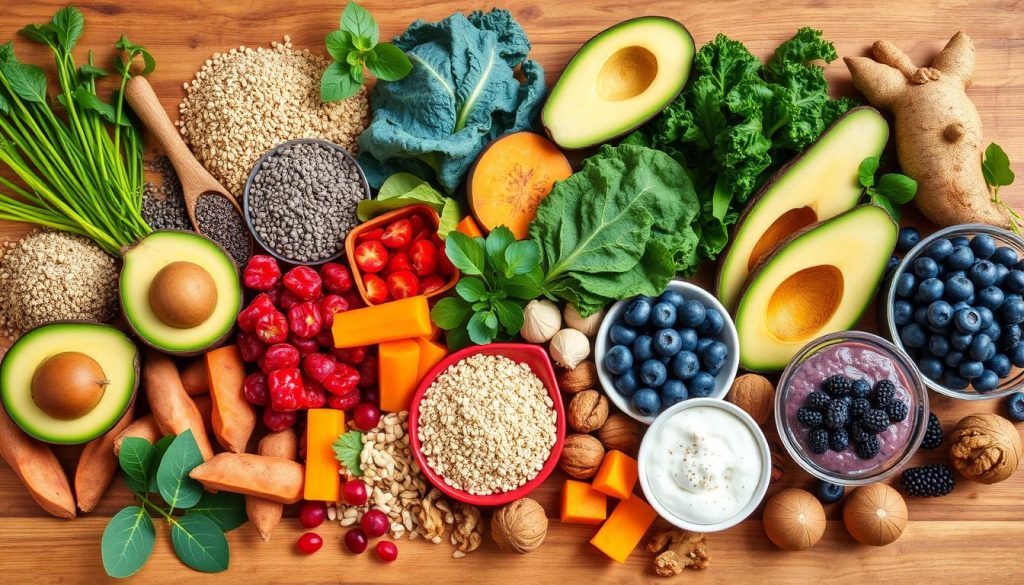
Smart Snacking: Healthy Options Between Meals
It’s not necessary to skip snacks to maintain a balanced diet. Healthy snacks are crucial for your nutrition plan. By choosing wisely, you can enjoy foods that give you energy and nourish your body between meals.
Portion Control Guidelines
For portion control, moderation is essential. Follow these guidelines to avoid overeating:
- Keep snack portions between 100-200 calories per serving.
- Opt for nutrient-dense foods like fresh fruits, vegetables, or protein-rich items.
- Practice mindful eating and plan your meals to avoid mindless snacking.
Quick and Easy Snack Preparations
Having healthy snacks ready can be a lifesaver when hunger hits. Here are some quick and easy ideas:
- Greek yogurt with fresh berries and a sprinkle of nuts
- Sliced cucumber or bell peppers with hummus
- Apple slices with a tablespoon of nut butter
- Hard-boiled eggs paired with a small piece of whole-grain toast
- Handful of mixed nuts or seeds
By adopting these smart snacking habits, you can keep your diet balanced. This supports your long-term health and wellness goals.
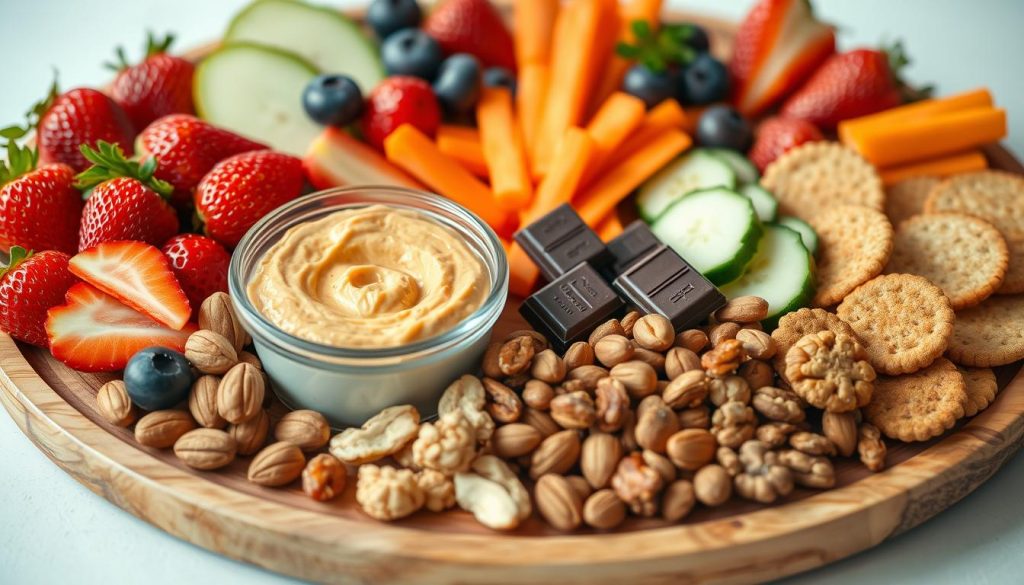
“The key to smart snacking is choosing nutrient-dense options that fuel your body and satisfy your hunger in a balanced way.”
Meal Planning Strategies for Balanced Nutrition
Keeping a balanced diet can be tough in our fast-paced lives. But, with smart meal planning and meal prep, it becomes much easier. By planning ahead, you can ensure a variety of healthy breakfast options, easy healthy dinners, and snacks for the week.
Understanding the macronutrients and micronutrients your body needs is crucial. This knowledge helps you pick recipes that meet your dietary needs and tastes.
Here are some effective meal planning tips:
- Check your pantry and fridge to see what you already have. This makes meal planning easier.
- Batch cook items like grains, proteins, and roasted veggies. They’re great for many healthy breakfast options and easy healthy dinners.
- Prepare your lunches in advance. This way, you have healthy meals ready to go.
- Try new cooking tips and recipes. Include a variety of leafy greens, lean proteins, whole grains, and heart-healthy fats to keep meals interesting and balanced.
Spending a bit of time each week on meal planning and meal prep can change your nutrition approach. It opens up a world of tasty, healthy breakfast options and easy healthy dinners that are good for you and delicious.
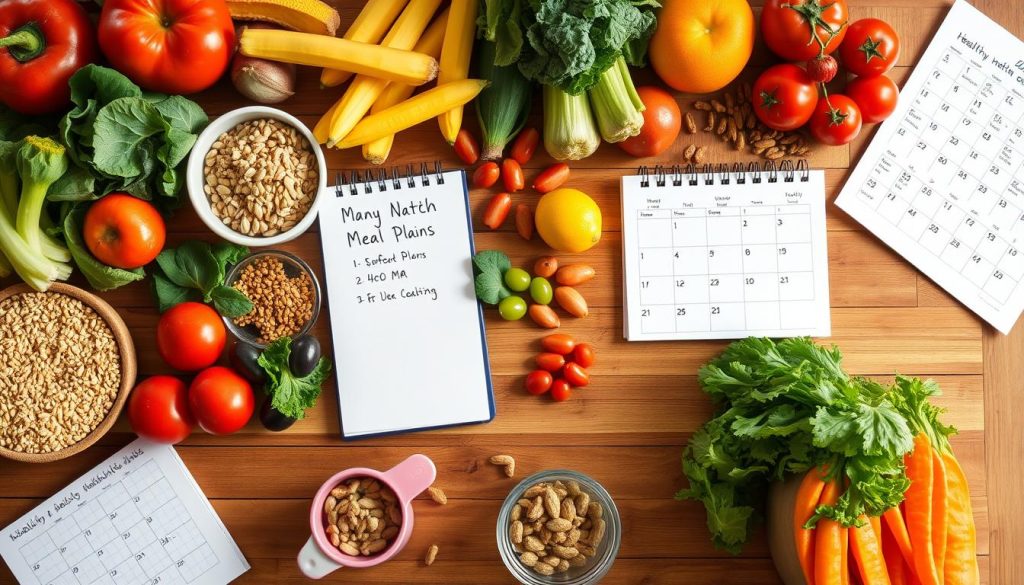
“The key to a balanced diet is planning, not perfection. Start small and build healthy habits that work for your lifestyle.”
Understanding Food Labels and Making Informed Choices
Deciphering food labels can be daunting, yet it’s essential for selecting healthier options. When examining food labels, focus on the nutrient content, ingredient list, and any organic foods, gluten-free options, or low-sugar foods highlighted. These details are key to making informed decisions.
Begin by reviewing the nutrition facts panel. It offers insights into calories, macronutrients (carbs, protein, fat), and micronutrients (vitamins, minerals). Opt for foods with more fiber, protein, and nutrients, and less added sugars, saturated fats, and sodium.
- Inspect the ingredient list for whole-food items and avoid products with many unknown, processed additives.
- Look for the organic foods label, which means the product was grown without synthetic pesticides or genetically modified organisms.
- For those with dietary restrictions, the gluten-free options label helps identify suitable choices.
By learning about food labels and choosing healthy food options, you can make better decisions for your health. A diet rich in whole, nutrient-dense foods is crucial for long-term health and vitality.
“Knowing how to read and understand food labels is the first step towards making healthier choices for you and your family.”
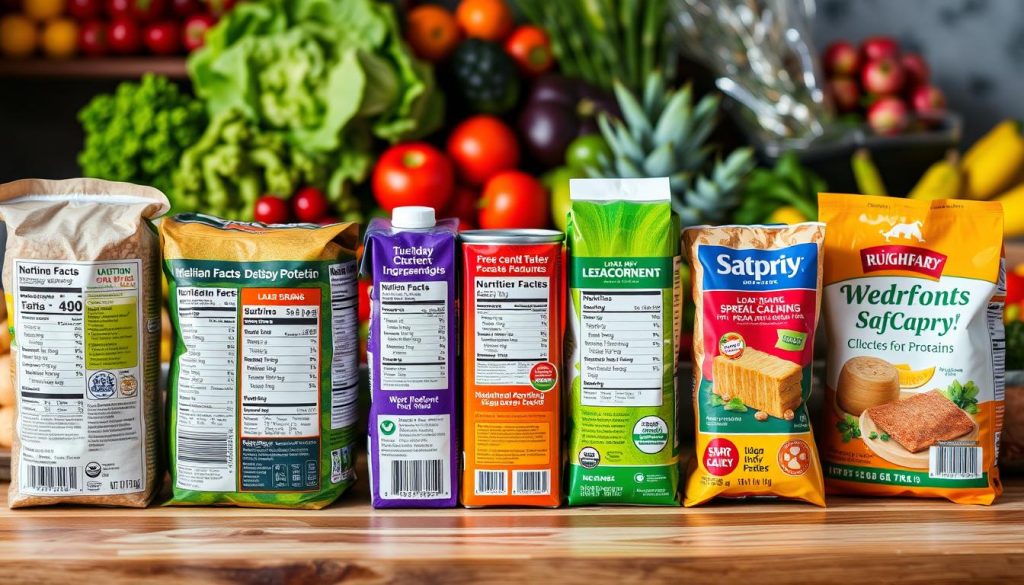
Conclusion
In our exploration of the top 10 healthy food options, it’s evident that a diverse diet is crucial for lasting wellness. Leafy greens, lean proteins, whole grains, and heart-healthy fats are all essential. Each group contributes significantly to our health and well-being.
Choosing wisely and focusing on a balanced diet, healthy food options, and nutritious foods opens the door to optimal eating for wellness. Small, consistent changes in your lifestyle choices can greatly improve your physical and mental health.
Take advantage of the wide range of healthy food options out there. Try new things like ancient grains, plant-based proteins, or more leafy greens. The journey towards a balanced diet and nutritious foods is endless. Start this path to a healthier, more vibrant life today.

